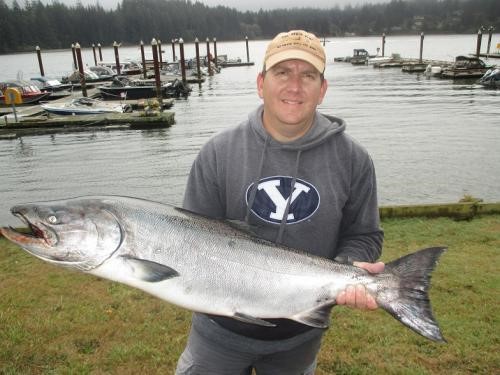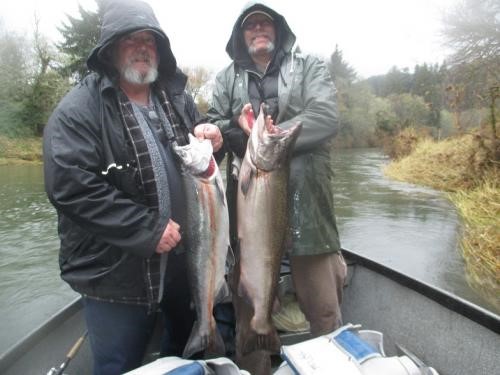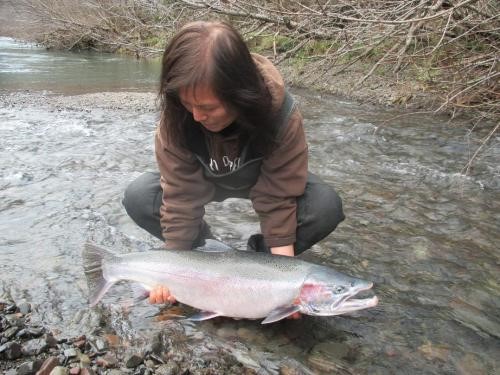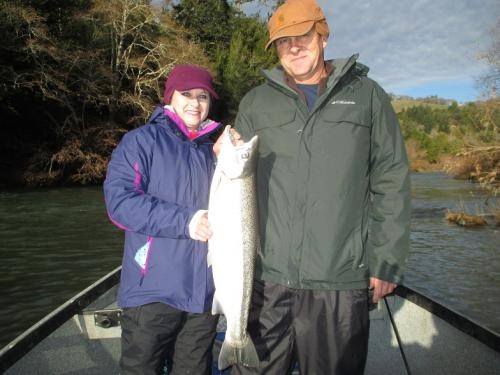Rivers
McKenzie River
Named after a Scottish fur trader who explored parts of the Pacific Northwest, the McKenzie River flows 90 miles generally due west out of Willamette National Forest located in the High Cascades and it eventually feeds into the Willamette River just north of Eugene Oregon. The McKenzie starts as the outlet stream from from Clear Lake which is reputed for its high water quality and a constant year-round temperature of 38 degrees. Near to the source it actually flows underground through a lava bed for 3 miles before re-emerging clear and ice cold. The McKenzie drainage comprises and area 1300 square miles, 96 percent of which is forested and 4 percent dedicated to agriculture. The cities of Eugene and Springfield benefit from the river's high water quality as they have tapped the river and adjacent aquifers to provide water to some 200,000 plus residents. Within the river and its tributaries, there are a number of dams and power projects associated with the Eugene Water & Electric Board, Army Corps of Engineers, and Bonneville Power who utilize and manage the river for flood control and hydro-electric power.
Renown for its aesthetic appeal and natural beauty, the McKenzie River corridor provides a diverse range of recreational opportunities including kayaking, rafting, hiking and mountain biking the adjacent trails, camping, and of course, fishing. The now famous McKenzie River Drift Boat actually evolved on this river and sports a unique design creating an incredibly efficient white-water friendly fishing vessel. Many of the boats are manufactured in the Pacific Northwest and now utilized not only in the U.S., but on rivers throughout the world.Numerous species of fish occupy the McKenzie's water. Such residents include Bull Trout, Mountain Whitefish, Sculpin and Chubs, while Rainbow & Cutthroat Trout, Spring Chinook Salmon, and Summer Steelhead represent the more sought after fish targeted by hopeful anglers. The McKenzie has a decent population of wild Rainbows known as “Redsides” and it also receives supplemental plantings of hatchery reared Rainbows throughout the spring and summer. This hatchery program has proven immensely successful and draws in anglers from far and wide year after year.
Some years see very good returns of Spring Chinook to the McKenzie. A hatchery located on the lower river near Leaburg produces salmon smolts, juvenile Springers that are released annually to supplement the wild population. Once released, these young fish head downstream in short order migrating to the Pacific Ocean where they enjoy a large food base for several years before returning to the McKenzie as adult salmon ready to spawn. Only hatchery produced Spring Chinook may be harvested on the McKenzie and they are identified by a missing adipose fin. A variety of baits and lures represent the most popular fishing tactics.
The McKenzie also has an on-going hatchery program for the production of Summer Steelhead. These fish were originally introduced to the McKenzie River and the program has created a very popular fishery. Once hooked, these feisty fish often put on quite a battle with jumps, somersaults and blazing runs that are long remembered. Depending on the river conditions, baits lures and even flies can all prove very effective.
Guests are enjoying Great Fun on our McKenzie River Summer Trout Trips
Summer Greetings from Roaring Fork Guide Service
McKenzie River Trout Fishing Adventure
Umpqua River
Flowing over 200 from miles from its headwaters in the Cascade Range to the Pacific Ocean at Winchester Bay, the Umpqua River offers an almost unrivaled diversity in the eco-regions it drains, andthe species of fish it supports along with the consequential plethora of angling opportunities created. Large tributaries including the North & South Umpqua rivers and the Smith River all feed the main stem and make the Umpqua one of western Oregon's largest rivers. The headwaters emerge in the heavily forested timber lands of the Cascades, flowing generally northwest. Just past Roseburg, the North and South forks combine to form the main stem which then passes through the Coast Range and slowly meanders through small agricultural valleys and pasture land supporting scattered oak and maple groves below fir-lined ridges. The river corridor then takes on a more canyonesque character as it continues west past Elkton and Scottsburg, finally opening up to the larger estuary near Reedsport at Hwy 101. The lower estuary has a more marine-like feel as seals, gulls, and sand dunes contribute to its character. The Umpqua River has a relatively long zone of tidal influence extending all the way from Scottsburg on through Winchester Bay, its gateway to the Pacific.
Sturgeon, Salmon, Steelhead, Trout, and Smallmouth Bass comprise the more popular fisheries the Umpqua offers, while Shad, Striped Bass and Surf Perch offer additional angling opportunities. Localsboast that virtually any time of the year there is something to catch in the Umpqua. Crabbing in Winchester Bay is very popular and at times quite productive. Though Oregon's state record Chinook Salmon was caught in the Umpqua River, there may well be more passion, fame and lore connected to Umpqua steelhead fishing. A legacy of fly fishing for Summer-Run Steelhead on the North Umpqua near Steamboat runs deep in the hearts of many anglers thanks, in part, to popularization and tales depicted by famed Western novelist Zane Grey. The Main Stem Umpqua and the South Fork get quite a bit of attention for Winter-Run Steelhead.
The Smallmouth Bass which was not a native to the Umpqua, has ironically become a summer favorite on the river. They are believed to have been washed accidentally from a nearby pond into the river during the flood of 1964 and the rest is history. To say they have thrived would be an understatement. Since the river temperature often reaches the upper 70s F in summer, it provides a great temperature regime and habitat for the bass. Loaded with crayfish and baby shad, there exists an excellent food base and now a consequent unbelievable Smallmouth population where putting 100 fish in the boat on a summer outing is commonplace. With often non-stop action and comfortable summer temperatures, this fishery indeed creates an perfect opportunity for getting kids hooked on fishing
RFGS Wishes Everyone Great New Fishing Adventures in the New Year
As our McKenzie River Salmon Season comes to a close, we now have reports of freshly arriving Salmon in Oregon’s coastal rivers
Siuslaw Salmon Fishing
Siuslaw River
The Siuslaw is Oregon's closest coastal river to the Eugene/Springfield area. It was named after the native people who originally lived along its bank's until they were relocated to a reservation at Yachats in 1860. The river is about 110 miles long and drains an area of 773 square miles. Most of the drainage is timberland and National Forest. Several significant tributaries feed the Siuslaw River contributing to its overall size. Lake Creek flows into the Siuslaw in Swisshome at a spot known as “The Forks.” Much further down river in the tide water, The North Fork Siuslaw flows into the Main Stem near Florence.
Today, Fall Chinook Salmon and Winter Steelhead get most of the attention from anglers. Most of the Chinook fishing takes place in the tidal zone during the months of September, October and November. Trolling baits and spinners seems to be the most popular method for targeting these Fall Chinook. As the season progresses, some folks also choose to suspend baits below a float along the banks and through the flats of the upper tide water. Most of the Winter Steelhead fishing occurs further upriver in the free flowing waters from December on into April. Regulations regarding fishing for Coho Salmon can vary drastically from year to year based on population projections. When the fish are abundant and fishing and harvest is permitted, this can be an incredibly fun fishery as Silver Salmon are super aggressive and will readily chase after a retrieved spinner or even large flies in addition to the baits and lures that are commonly trolled. Late September, October, November and December are all good months to fish for Coho. Decent opportunities for the harvest of Dungeoness Crab in the lower estuary below the Hwy 101 Bridge at Florence on down to the bar also occur during the fall months, particularly during extended periods of no rain.
As our McKenzie River Salmon Season comes to a close, we now have reports of freshly arriving Salmon in Oregon’s coastal rivers
As the high water levels in most of our Coastal Rivers drop, Fall Chinook fishing in the free-flowing sections has improved
March can be a Special Month for Winter Steelhead Fishing on Oregon’s Coastal Rivers
Siletz River
just beyond Echo Creek, while the drift boat fishermen who chase after Winter Steehead love to row various different runs from Moonshine Park on down to Morgan Park well below the town of Siletz. The section from Moonshine Park to Twin Bridges (also known as Sam's Creek) is extremely scenic with its pool & drop character and numerous feeder stream water falls that plunge directly into the Siletz. This run would not be a good choice for a novice rower. Many fishing trips either start or finish at several convenient boat ramps near or in the town of Siletz which has a great small Cafe and also a brew pub. A short 20 minute drive from Siltez is Newport, a larger coastal town that offers plenty of good eateries and lots of choices for lodging. Nearby beaches, crabbing docks, whale-watching opportunities, summer festivals, the Oregon Coast Aquarium, the Hatfield Science Center, and events at the Newport Performing Arts Center, all combine to make Newport a favorite vacationing spot.
In the tidewater, trolled plug-cut baits and spinners account for most of the Fall Chinook hook-ups though enough fish hit bait-wrapped plugs to make them a viable option. Further upriver, eggs and shrimp, be they back-bounced or float fished, are considered the number one choice. Many of the Siletz Winter Steelhead are taken on side-drifted eggs and jigs, while back-rowing plugs and pitching spinners will also produce. Later in the year, fly fishing can also be quite effective on the Summer-Runs.
RFGS Wishes Everyone Great New Fishing Adventures in the New Year
As our McKenzie River Salmon Season comes to a close, we now have reports of freshly arriving Salmon in Oregon’s coastal rivers
Gorgeous Scenery & Good Trout Fishing on the Upper McKenzie River
Coquile River
Both the North and South forks of the Coquille have relatively productive runs of Winter Steelhead from December on into April. On the South Fork, the hillsides along the river are very picturesque, thanks in part to the on-going grazing that helps preserve the pastoral quality of the vegetative mosaic where the forest is truly kept in check and the tree stands are limited to creek seeps and draws. Upriver of the town of Powers, the vegetative mosaic of the adjacent sloped ranch-lands begins to give way to a denser conifer forest. The South Fork Coquille is reputed for a strong run of hatchery Winter Steelhead that augments the wild run. All wild or non-fin-clipped steelhead must be released .Side drifting baits from a drift boat has become very popular in Coquille country, while jigs and bait suspended below a float, back-rowed plugs, and pitched spinners can all contribute to good catch numbers.
RFGS Wishes Everyone Great New Fishing Adventures in the New Year
WISHING YOU ALL FUN, GOOD HEALTH & CONTENTMENT IN THE NEW YEAR
March can be a Special Month for Winter Steelhead Fishing on Oregon’s Coastal Rivers
Elk River
Due to the relatively large size and super high quality of the Elk River salmon, many fishermen, some traveling great distances, come to Port Orford each year in late fall and winter to catch these amazing tackle-testing fish. The salmon begin to stage near the mouth in late September and early October, moving in and out with each tide while they wait for sufficient rain to result in enough rise in the river level to allow for passage up to spawning grounds. A long shallow area of tidewater along the sandy bluffs at the mouth can make these fish vulnerable and available to fishermen and seals alike sometimes for a month or two before the regular rains set in. By mid-November, the Elk River Chinook fishing is usually in full swing while in most other Oregon rivers salmon fishing has finished up. This can put a lot of attention and consequent fishing pressure on this beautiful little coastal stream during November and December.
While float fishing and back-bouncing baits are the primary fishing techniques employed to catch these big salmon, back-trolling diving plugs results in many hook-ups on Elk River Chinook each season. Around mid-December, Winter Steelhead begin to show up in the catch and from January through March they are the primary target. Most standard steelhead fishing techniques find success, but jigs and flies often prove very successful on the winter fish, especially during periods of low and clear water conditions.
The town of Port Orford is only minutes away from both the Elk and Sixes rivers. Whenever weather permits, a small fleet of commercial fishing boats are raised lowered by crane off the Port Orford Dock. Observing this process can be a fun diversion. Lodging, restaurants, fishing licenses and groceries are all available in town. (See our recommendation under “Lodging.”)
2023 Happy New Year from: Elk and Sixes Rivers
2023 Happy New Year to Friends, Customers and Readers alike Elk and Sixes
Late Fall/Winter Chinook in the Elk and Sixes Rivers – Better Late Than Never
Sixes River
A relatively short coastal stream flowing about 30 miles westward from its upper reaches in Siskiyou National Forest to the Ocean at Cape Blanco, the Sixes River is popular for big late-run Fall Chinook and Winter Steelhead. Like its sister river the Elk, the Sixes is located very close to Port Orford where it helps diversify the local fishing choices. After high water events, the Sixes tends to stay murky longer, thereby offering a great alternative fishing option once the Elk River has dropped into a low and clear condition.
In early October, high tides and brief periods of heavy rain will pull the Fall Kings into the lowest holes between Hwy 101 and the Ocean. The fish can get kegged up in these deep holes waiting for more rain to raise the river level enough to allow fish further access upriver to spawning grounds. Tossing spinners, float fishing baits, and stripping in heavily weighted flies can all produce catches as the fish wait to move on up the river. Once regular rains arrive in themonths of November and December, drift boat fishing from Edson Creek Park all the way down to the Cape Blanco Park boat launch becomes the prevailing fishing method. Due to heavy logging in the upper drainage however, muddy water conditions following big rains can dirty up the river enough to prevent decent fishing for weeks on end. Wild Winter Steelhead begin to show up around mid-December and continue to arrive through March. Fishing for Chinook salmon is permitted from Edson Creek on down to the mouth, while steelhead fishing is allowed much further upriver.
While the neighboring Elk River tends to run swift and shallow, the Sixes has a slightly different feel to it, as it eases around large bends, meandering past lower river cattle ranches on down through Cape Blanco State Park. In contrast to the Elk River, though the Sixes river is not planted with any hatchery smolts, it is fairly common to catch stray Elk River hatchery Chinook that mistakenly took a wrong turn into the Sixes River. In low water years, fishing forthese big bright “Hawgs” can hold up through December Due to the relatively large size and super high quality of the Elk River salmon, many fishermen, some traveling great distances, come to Port Orford each year in late fall and winter to catch these amazing tackle-testing fish. The salmon begin to stage near the mouth in late September and early October, moving in and out with each tide while they wait for sufficient rain to result in enough rise in the river level to allow for passage up to spawning grounds. A long shallow area of tidewater along the sandy bluffs at the mouth can make these fish vulnerable and available to fishermen and seals alike sometimes for a month or two before the regular rains set in. By mid-November, the Elk River Chinook fishing is usually in full swing while in most other Oregon rivers salmon fishing has finished up. This can put a lot of attention and consequent fishing pressure on this beautiful little coastal stream during November and December.
2023 Happy New Year to Friends, Customers and Readers alike Elk and Sixes
2023 Happy New Year from: Elk and Sixes Rivers
Late Fall/Winter Chinook in the Elk and Sixes Rivers – Better Late Than Never
South Santiam River
A small run of Winter Steelhead arrive in the South Fork between January through May while the hatchery-reared Summer-runs provide great sport from May on into September. A run of Spring Chinook adds to the fishing opportunities from April through July. Most of the Springers are caught on bait or plugs. Drift fishing baits or Corkies & yarn account for plenty of Summer Steelhead hook-ups, while jigs and baits fished below a float along with retrieved spinners & spoons account for additional action. Back-rowing small Hot Shots and even a swung fly can all put fish in the box. In the good years when plenty of steelhead arrive at the hatchery below Foster Dam, a n effective recycle program is conducted to return hatchery steelhead back downriver to Pleasant Valley Bridge or to Waterloo Park in order to give anglers extra fishing opportunities.
2018 Newsletter from Roaring Fork Guide Service – McKenzie River Fishing Trips Spring – Summer – Fall
As the high water levels in most of our Coastal Rivers drop, Fall Chinook fishing in the free-flowing sections has improved
Willamette Middle Fork River
Spring Chinook fishing here usually runs from April through July, peaking in May and June. The Summer Steelhead fishing will sometimes start in late arch and continue into October. Most of the classic steelhead fishing methods will produce catches. Casting spinners and swinging heavily weighted flies are both popular and very effective methods for catching these feisty Summer-Runs. As in most valley rivers, back bouncing and float fishing baits in the deeper holes tends to be the number one method for catching the Springers. Back trolling a diver-bait set-ups in the deeper runs can be equally productive.
From the start of the Main Stem Willamette at the confluence of the Coast Fork, the river corridor begins to take on a very different character, as residences and development becomes more visually obvious. Over the past decade ODFW has engaged in a very popular and successful experiment in steelhead release locations. Approximately 10,000 smolts per boat ramp are released annually within the Eugene and Springfield city limits. The returning adult steelhead actually find their way back to the pools and runs near their original release points and linger long enough to give fishermen a fair shot at catching a nice fish. This urban fishery has become known as the “Town Run” and is immensely popular for locals who like to do very short drifts or just put in and take out at the same launch, no vehicle shuttle required. It affords folks the opportunity to fish from the boat for just an hour or two either before or after work.





